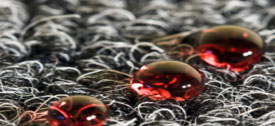Why does my chenille fabric have these light spots?
Occasionally, we'll get a call from a client, "I have a light spot on my chenille fabric. Can you come and remove it?" If it has been caused by a water-based spill, then no, we may not be able to remove it. Often, a color change of this sort on a velvet or chenille has been caused by contact with water, or a water-based spill. Chenille (French for "caterpillar") is often chosen for its ultra-soft, luxurious "hand". It is basically a less dense version of velvet, and is generally made out of cotton, synthetic blends, and / or rayon. Its lack of density can lead to a "matting" of the pile in high-use areas, particularly seat cushions, and those flattened areas will appear lighter. Rayon chenille, in particular,will absolutely not accept any contact with water. If it becomes wet, the pile is irreversibly and permanently changed. Specifically, the fabric loses its resilience. As a result, the fabric becomes "directional". When new, a rayon chenille pile will not show an appreciable change in appearance when brushed first one way, then another. However, after wetting, it will behave more like some velvets, which can lighten and darken dramatically when you reverse pile direction. Also, the pile will tend to lay down flat, and no longer stand up straight, thus bouncing more light back, and appearing lighter, rather than absorbing and shading light between strands. The only ultimate solution in some cases is to wet clean the entire piece, thus creating a uniform, if not ideal, appearance. (And even then, some concerns remain; a less-than-meticulous cleaning can yield a streaky, uneven appearance.) Until that time comes, your chenille should probably be protected with Fiber-Shield®, in order to maximize its water repellent feature, and minimize risk of pile distortion





